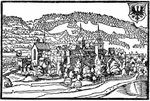This was another French infantry regiment captured at Blenheim and is no.128 in my list of French infantry flag sets...
First raised 24th October 1688 by Philippe-Marie de Montmorency, Prince de Robecque
Hall says: "The red/isabelle colours match the arms of Montmorency."
Service:
1688 Army of the Alps
1690 Battle of Staffarde
1691 Conquest of Nice
1691 13th December given to Charles de Montmorency, Prince de Robecque, brother of the previous colonel
1693 Battle of La Marsaglia
1696-1697 Army of the Rhine
1701 Army of Germany
1702 Battle of Friedlingen
1703 Siege of Breisach; then put into garrison there
1704 Army of Bavaria; taken prisoner at the battle of Blenheim
1704 26th October given to the Comte de Saint-Vallier [who was captured at Blenheim]
1705 Prisoners exchanged
1706 Army of Flanders; battle of Ramillies
1708 Defence of Lille; battle of Oudenarde
1709 Defence of Tournai; taken prisoner there and exchanged the same year
1710-1714 In garrisons in Flanders
1714 7th April Given to Henri-Bernard de la Croix, Chevalier de Saint-Vallier, brother of the previous colonel
1714 15th November "reformed" (Susane) - disbanded (Hall)!
There is also some confusion with another possible flag design carried by the regiment when commended by the Comte de Saint-Vallier.
The uniform is unknown.

























































